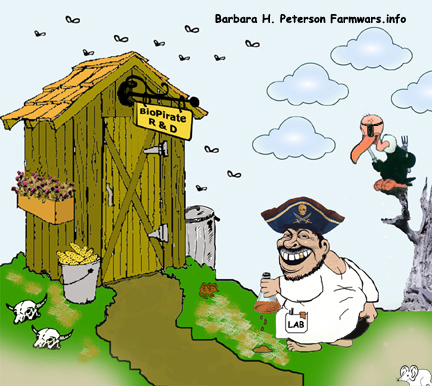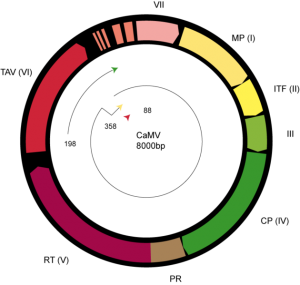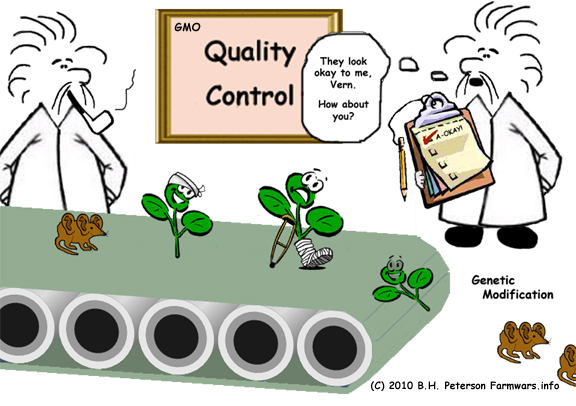
THE BIO-PIRATES OF SCIENCE: GENETIC ENGINEERING - SCIENCE OR HOAX?
And to top it all off, the U.S. government, which is supposed to be financed by we the people, is actively promoting this biological warfare by stealthily allowing the rampant infection of approximately 85% of our processed food with unregulated transgenes that Monsanto executives admit will have unknown effects on the environment and life.

Did I mention that these transgenes also include a virus that is 70-90% identical to the HIV and Hep B viruses?
Because of the limitations of the technology, in most cases the process will also necessarily involve the insertion of genetic material from at least one foreign pathogen, the most common of which (the 35S promoter) is taken from a virus which is very similar to Hepatitis B and related to HIV. The consequences of using such elements have even been questioned by researchers at the John Innes Institute, one of the UK’s premier research establishments in the field of agricultural genetic engineering. Despite this, routine use of such pathogen-derived elements continues.
http://www.btinternet.com/~nlpWESSEX/Documents/eagmconf.htm
The Cauliflower Mosaic Virus promoter (CaMV 35S) is used in most transgenic crops to activate foreign genes which have been artificially inserted into the host plant. It is potentially dangerous.
Did you get that? Approximately 85% of the processed food on our store shelves contains products infected with transgenic material containing a virus that is 70-90% identical to the HIV and Hep B viruses. And our government, in collusion with companies such as Monsanto, is in charge of the attack, using “science” as a battle shield to fend off any who would question their tactics. But can what these people are doing actually be called “science?”
The “Science” of Genetic Engineering
The scientific method is defined by Merriam-Webster Online as:
Principles and procedures for the systematic pursuit of knowledge involving the recognition and formulation of a problem, the collection of data through observation and experiment, and the formulation and testing of hypotheses.
http://www.merriam-webster.com/dictionary/scientific%2Bmethod
Scientific methods are based on the recognition and formulation of a problem, collecting data through experiment and observation, then the formulation of a hypotheses, which leads to a solid conclusion of fact.
After only 20 years or so of development genetic engineering still involves processes which are random and ‘trial and error’ in nature, and in that sense they are imprecise and unscientific. The biotechnologist has little or no prior predictive power as to how a new gene will behave in the host organism. Without demonstrable predictive power it is inappropriate to refer to any process as ‘engineering’ or ‘science-based’.
After well over 20 years, just why is the so-called genetic engineering process still trial and error?
Even in simple biological organisms like bacteria, the total potential interactions between genetic components run into many millions. These relationships have until now been managed by the intelligence of the organism’s own DNA. It is now proposed that these relationships should be ‘controlled’ by the same species whose own limited intelligence has mistakenly and irretrievably peppered the globe with unmanageable nuclear waste – man.
In traditional plant breeding it is the highly sophisticated discriminatory intelligence of the plant which ultimately determines which genes may be accepted as part of the newly created organism, and it is that same intelligence which determines their placement and functioning within it. This process is driven by the information and knowledge contained within the DNA of the plant itself and exercised as an integral part of the natural sexual breeding process.
With genetic engineering this process is completely bypassed. Single genes are selected by the ‘scientist’ and randomly inserted into the genome of the host organism. The scientist has no control over their placement. In fact the plant geneticist has little or no knowledge as to where the new genes should be placed in any case; and usually he does not know where they have actually lodged even after his work has been completed. He simply “hopes for the best.” Furthermore the inserted genes will frequently be taken from totally unrelated species.
The genetic engineering process:
Aggie the Traveling Agrobacterium
And still, no valid risk assessment testing is done.
The problem with calling genetically engineered organisms safe is that there are no valid risk assessments being done on them. There is no research, really, being done into the health or environmental effects of a genetically engineered organism. Certainly no work that is published in the peer-reviewed literature that isn’t proprietary. Corporations promoting these things claim that they have done research, but you can’t get any information on it because it’s all claimed to be proprietary.
As Dr. Bereano explains in this interview, genetic engineering is based on an extremely oversimplified model that suggests that by taking out or adding one or several genes, you can create a particular effect or result.
However, this reductionist model is nowhere near complete.
“First of all, genomes are so complicated with so many interactions within the genes of the genome that we don’t really understand it well,” Dr. Bereano says. “Let me give a simple example.
The genome in a cell in your eyeball is identical to the genome of a cell in your pancreas, but your eyeball does not make insulin. The constituents of what’s in a genome are not the end of the story as to what that cell is going to produce and do.
There are in the human body maybe about 30,000 genes but there are millions of proteins. These proteins are produced by very subtle and different interactions among the genes in different locations in the body. There are proteins which turn on insulin manufacturing to the cells in the pancreas and don’t turn it on in your eyeball
… It’s important to understand that the structure of the genome is not determinative of what that cell does.
Yet, the kind of mental model that’s being used in all of these discussions is what I call the Lego model or the tinker toy model. Let’s take out a yellow piece or let’s put in a green piece… but it’s not an issue just of structure—it’s of interaction.
These things are not being studied well. How stable is this genome after it is altered? In many instances we don’t know. It might change spontaneously. There are lots of questions there.
They have this very simplistic model and then they claim that these results are going to flow from it. But biology is much more complicated than that.”
http://articles.mercola.com/sites/articles/archive/2011/04/02/dr-philip-bereano-on-gmos.aspx
Laboratory Accreditation and Industry Oversight
We can see from the above information that the “science” of genetic engineering is conducted in no way resembling any form of true scientific methodology, so how do we know that companies such as Monsanto are even qualified to conduct such experiments? We don’t. Biotech laboratories seem to be bereft of any form of mandatory accreditation process. In fact, it seems that any accreditation is voluntary.
Theoretically, it seems that Monsanto could set up shop in a cardboard box, create a frankenvirus, get peer reviewed studies from other labs in cardboard boxes, then unleash this abomination on the world without consequences for its actions if/when people die. Especially when backed by the U.S. government. I cannot find any evidence that accreditation and compliance with set scientific standards is anything but voluntary. You pay to play.
A quick search of The American Association for Laboratory Accreditation for Monsanto Crop Analytics provides us with the following 2 accreditations involving one laboratory HERE and HERE, which are very specific regarding only a certain few procedures.
On the USDA site, in the Animal and Plant Health Inspection Service (APHIS) section, the following authority is claimed:
In order to protect plant health, Biotechnology Regulatory Services (BRS) implements the APHIS regulations for certain genetically engineered (GE) organisms that may pose a risk to plant health. APHIS coordinates these responsibilities along with the other designated federal agencies as part of the Federal Coordinated Framework for the Regulation of Biotechnology.
There are regulations for “certain” GE organisms that may pose a risk to plant health. How about posing a risk to human health? Evidently, that doesn’t count. So off we go, down the road, Monsanto hand in hand with the USDA, conducting chemical and biological warfare on American citizens first, then spreading onwards and upwards to the rest of the world. Accreditation? We don’t need no stinkin’ accreditation – not with the USDA covering our backs!
APHIS inspectors and compliance specialists perform targeted inspections of field tests and thoroughly evaluate all potential noncompliance incidents. BRS also evaluates facilities, equipment, records of developers, and potential incidents reported by permittees. Authorizations under the permitting and notification procedures require that noncompliance incidents be self-reported within designated time frames.
http://www.aphis.usda.gov/biotechnology/compliance_main.shtml
A self-reporting clause. The agency, (APHIS/USDA), conducts “targeted inspections” and evaluates “non-compliance” issues that are self-reported by the permittees. It can’t get any better than that for Monsanto.
The Sky’s the Limit
So, without proper oversight, genetic markers in hand, Monsanto and the U.S. government are conducting the world’s largest unscientific, under-regulated experiment on the population at large. And we are paying for it. We are systematically being poisoned, our DNA is changing, new and resistance bacteria and superweeds are cropping up, and Monsanto gets paid for the carnage, courtesy of the U.S. taxpayer. We are literally paying for our own demise at the hands of so-called “scientists” gone wild. This is not a science fiction movie, it is what we are living, and somehow, I don’t think Duck and Cover will cut it.
A special thanks to the following Facebook Friends for help in the research on accreditation: Peyton, Jo, Barry, and Tim.
VIEW VIDEO
April 4, 2011


